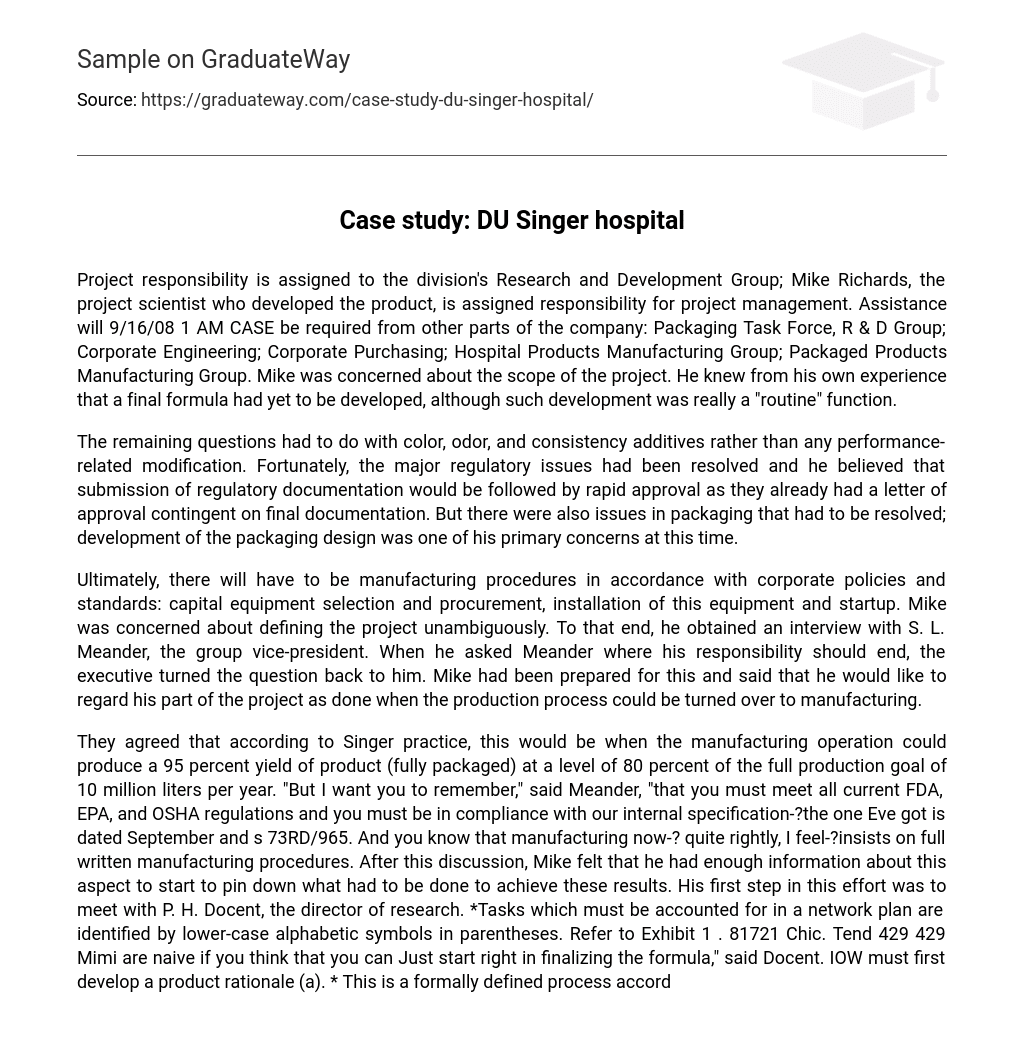Project responsibility is assigned to the division’s Research and Development Group; Mike Richards, the project scientist who developed the product, is assigned responsibility for project management. Assistance will 9/16/08 1 AM CASE be required from other parts of the company: Packaging Task Force, R & D Group; Corporate Engineering; Corporate Purchasing; Hospital Products Manufacturing Group; Packaged Products Manufacturing Group. Mike was concerned about the scope of the project. He knew from his own experience that a final formula had yet to be developed, although such development was really a “routine” function.
The remaining questions had to do with color, odor, and consistency additives rather than any performance-related modification. Fortunately, the major regulatory issues had been resolved and he believed that submission of regulatory documentation would be followed by rapid approval as they already had a letter of approval contingent on final documentation. But there were also issues in packaging that had to be resolved; development of the packaging design was one of his primary concerns at this time.
Ultimately, there will have to be manufacturing procedures in accordance with corporate policies and standards: capital equipment selection and procurement, installation of this equipment and startup. Mike was concerned about defining the project unambiguously. To that end, he obtained an interview with S. L. Meander, the group vice-president. When he asked Meander where his responsibility should end, the executive turned the question back to him. Mike had been prepared for this and said that he would like to regard his part of the project as done when the production process could be turned over to manufacturing.
They agreed that according to Singer practice, this would be when the manufacturing operation could produce a 95 percent yield of product (fully packaged) at a level of 80 percent of the full production goal of 10 million liters per year. “But I want you to remember,” said Meander, “that you must meet all current FDA, EPA, and OSHA regulations and you must be in compliance with our internal specification-?the one Eve got is dated September and s 73RD/965. And you know that manufacturing now-? quite rightly, I feel-?insists on full written manufacturing procedures. After this discussion, Mike felt that he had enough information about this aspect to start to pin down what had to be done to achieve these results. His first step in this effort was to meet with P. H. Docent, the director of research. *Tasks which must be accounted for in a network plan are identified by lower-case alphabetic symbols in parentheses. Refer to Exhibit 1 . 81721 Chic. Tend 429 429 Mimi are naive if you think that you can Just start right in finalizing the formula,” said Docent. IOW must first develop a product rationale (a). * This is a formally defined process according to company policy.
Marketing expects inputs at this stage, manufacturing expects their voice to be heard, and you will have to have approvals from every unit of the company that is involved; all of this is reviewed by the Executive Committee. You should have no trouble if you do your homework, but expect to spend a good eight weeks to get this done. ” “That certainly stretches things out,” said Mike. “l expected to take 12 weeks to develop the ingredient formula (b) and you know that I can’t start to establish reduce specifications (c) until the formula is complete. That’s another three weeks. Miss, but while you are working on the product specifications you can get going on the regulatory documentation (d). Full internal specifications are not required for that work, but you can’t start those documents until the formula is complete. ” Miss, and I find it hard to believe that we can push through both preparation of documents and getting approval in three weeks, but Environmental swears it can be done. ” “Oh, it can be done in this case because of the preparatory work. Of course, I won’t ay that this estimate of three weeks is as certain as our other time estimates.
All we need is a change of staff at the Agency and we are in trouble. But once you have both the specifications and the approval, you can immediately start on developing the production processing system (g). ” Miss, and how I wish we could get a lead on that, but the designers say that there is too much uncertainty and they won’t move until they have both specifications and regulatory documentation and approval. They are offering pretty fast response; six weeks from start to finish for the processing system. ” “They are a good crew, Mike.
And of course, you know that you don’t have to delay on starting the packaging segment of this project. You can start developing the packaging concept (e) Just as soon as the product rationale has been developed. If my experience is any judge, it will take a full eight weeks; you’ll have to work to keep the process from running forever. ” “But as soon as that is finished we can start on the design of the package and its materials (f), which usually takes about six weeks. Once that is done we can start developing the packaging system (h), which shouldn’t take longer than eight weeks,” concluded Mike.





